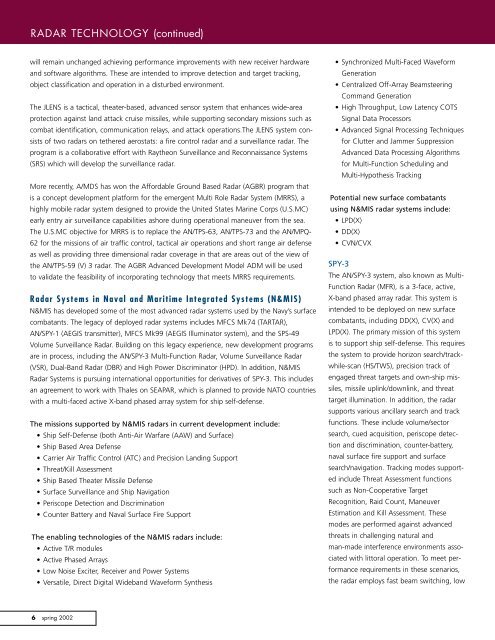Tech_020711.qxd - Raytheon
Tech_020711.qxd - Raytheon
Tech_020711.qxd - Raytheon
Create successful ePaper yourself
Turn your PDF publications into a flip-book with our unique Google optimized e-Paper software.
RADAR TECHNOLOGY (continued)<br />
will remain unchanged achieving performance improvements with new receiver hardware<br />
and software algorithms. These are intended to improve detection and target tracking,<br />
object classification and operation in a disturbed environment.<br />
The JLENS is a tactical, theater-based, advanced sensor system that enhances wide-area<br />
protection against land attack cruise missiles, while supporting secondary missions such as<br />
combat identification, communication relays, and attack operations.The JLENS system consists<br />
of two radars on tethered aerostats: a fire control radar and a surveillance radar. The<br />
program is a collaborative effort with <strong>Raytheon</strong> Surveillance and Reconnaissance Systems<br />
(SRS) which will develop the surveillance radar.<br />
More recently, A/MDS has won the Affordable Ground Based Radar (AGBR) program that<br />
is a concept development platform for the emergent Multi Role Radar System (MRRS), a<br />
highly mobile radar system designed to provide the United States Marine Corps (U.S.MC)<br />
early entry air surveillance capabilities ashore during operational maneuver from the sea.<br />
The U.S.MC objective for MRRS is to replace the AN/TPS-63, AN/TPS-73 and the AN/MPQ-<br />
62 for the missions of air traffic control, tactical air operations and short range air defense<br />
as well as providing three dimensional radar coverage in that are areas out of the view of<br />
the AN/TPS-59 (V) 3 radar. The AGBR Advanced Development Model ADM will be used<br />
to validate the feasibility of incorporating technology that meets MRRS requirements.<br />
Radar Systems in Naval and Maritime Integrated Systems (N&MIS)<br />
N&MIS has developed some of the most advanced radar systems used by the Navy’s surface<br />
combatants. The legacy of deployed radar systems includes MFCS Mk74 (TARTAR),<br />
AN/SPY-1 (AEGIS transmitter), MFCS Mk99 (AEGIS Illuminator system), and the SPS-49<br />
Volume Surveillance Radar. Building on this legacy experience, new development programs<br />
are in process, including the AN/SPY-3 Multi-Function Radar, Volume Surveillance Radar<br />
(VSR), Dual-Band Radar (DBR) and High Power Discriminator (HPD). In addition, N&MIS<br />
Radar Systems is pursuing international opportunities for derivatives of SPY-3. This includes<br />
an agreement to work with Thales on SEAPAR, which is planned to provide NATO countries<br />
with a multi-faced active X-band phased array system for ship self-defense.<br />
The missions supported by N&MIS radars in current development include:<br />
• Ship Self-Defense (both Anti-Air Warfare (AAW) and Surface)<br />
• Ship Based Area Defense<br />
• Carrier Air Traffic Control (ATC) and Precision Landing Support<br />
• Threat/Kill Assessment<br />
• Ship Based Theater Missile Defense<br />
• Surface Surveillance and Ship Navigation<br />
• Periscope Detection and Discrimination<br />
• Counter Battery and Naval Surface Fire Support<br />
The enabling technologies of the N&MIS radars include:<br />
• Active T/R modules<br />
• Active Phased Arrays<br />
• Low Noise Exciter, Receiver and Power Systems<br />
• Versatile, Direct Digital Wideband Waveform Synthesis<br />
6 spring 2002<br />
• Synchronized Multi-Faced Waveform<br />
Generation<br />
• Centralized Off-Array Beamsteering<br />
Command Generation<br />
• High Throughput, Low Latency COTS<br />
Signal Data Processors<br />
• Advanced Signal Processing <strong>Tech</strong>niques<br />
for Clutter and Jammer Suppression<br />
Advanced Data Processing Algorithms<br />
for Multi-Function Scheduling and<br />
Multi-Hypothesis Tracking<br />
Potential new surface combatants<br />
using N&MIS radar systems include:<br />
• LPD(X)<br />
• DD(X)<br />
• CVN/CVX<br />
SPY-3<br />
The AN/SPY-3 system, also known as Multi-<br />
Function Radar (MFR), is a 3-face, active,<br />
X-band phased array radar. This system is<br />
intended to be deployed on new surface<br />
combatants, including DD(X), CV(X) and<br />
LPD(X). The primary mission of this system<br />
is to support ship self-defense. This requires<br />
the system to provide horizon search/trackwhile-scan<br />
(HS/TWS), precision track of<br />
engaged threat targets and own-ship missiles,<br />
missile uplink/downlink, and threat<br />
target illumination. In addition, the radar<br />
supports various ancillary search and track<br />
functions. These include volume/sector<br />
search, cued acquisition, periscope detection<br />
and discrimination, counter-battery,<br />
naval surface fire support and surface<br />
search/navigation. Tracking modes supported<br />
include Threat Assessment functions<br />
such as Non-Cooperative Target<br />
Recognition, Raid Count, Maneuver<br />
Estimation and Kill Assessment. These<br />
modes are performed against advanced<br />
threats in challenging natural and<br />
man-made interference environments associated<br />
with littoral operation. To meet performance<br />
requirements in these scenarios,<br />
the radar employs fast beam switching, low
















